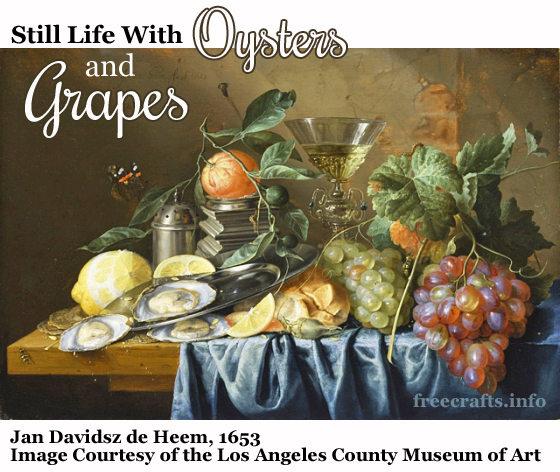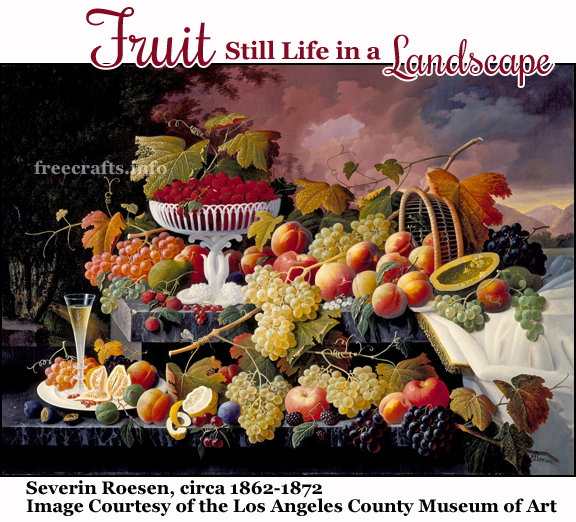Composing, Painting and Drawing Still Life Art
Still Life Definition: You could define a still life as being “A work of art that portrays inanimate objects”. When you compose your own still life painting or drawing, you get to choose the objects. They can be fruits, vegetables, foods, plants, flowers, vases, pottery, bowls, dishes, textiles, art supplies, musical instruments, decorative objects, or just about anything else.

Still Life With Oysters and Grapes, by Jan Davidz De Heem, 1653. This painting is in the collection of the Los Angeles County Museum of Art.
Choosing Which Objects Will Appear In Your Still Life Paintings or Drawings:
Your goals, vision, style and expertise can direct your choice of both props and materials when you are setting up your still life.
One approach: you can use the objects you choose to convey complex and diverse meanings.
A different approach: you can choose your props spontaneously if you like, grabbing a bunch of random objects from your studio or surroundings.
Yet another approach: collect objects that you think would work together to make a beautiful, pleasing composition.
If your intention is to compose a pretty picture, you might choose to incorporate objects such as rich textiles, delicious-looking ripe fruits, and assorted dishes, goblets, or a vase full of flowers. You could include objects that are either beautiful or ugly, but the trick would be to present either sort of object in a pleasing or imaginative way.

Fruit Still Life in a Landscape by Severin Roesen, a painting which could be described as primarily a still life, but also a landscape. The original artwork is in the collection of the Los Angeles County Museum of Art.
Still Life Artwork Makes a Great Gift: Perhaps you’d like to paint or draw a still life for a loved one, as a gift. If so, it could be interesting to create a composition comprised of objects that would be meaningful to the recipient in some way. If he’s a sports fan, you might want to paint a themed still life depicting memorobilia from his favorite sports team. If he’s a foodie, perhaps it would be more appropriate to concoct an image featuring his favorite foods and wines. If he’s a musician, his musical instrument could be the focal point of a still life painting that he would be sure to appreciate.
What would you incorporate into a still life you’d create for your parents / significant other / kids / grandkids / best friend(s)? It can be fun to imagine, and possibly even plan out and execute, interesting still life artworks designed with a particular recipient in mind.
Still Life Themes: Perhaps you want to convey a message through your still life. In that case, choosing objects that reflect the message is an interesting, and perhaps challenging, exercise. This is particularly rewarding when the result is a still life that provokes the viewer to think, to feel, and to react.
Some random examples of messages that could be expressed via still life art:
- “Reduce Reuse Recycle”.
- “A Knitter’s Stash.”
- “Cleanliness is next to Godliness”.
- “Happy Anniversary!”
- “Tropical Paradise”
- “Party on, dude!”
- Insert your favorite slogan or expression here.
I invite you to imagine a message or theme that is significant to you, and choose some objects that would successfully convey this message if you were to arrange them together in a still life. How would you arrange the composition to make them particularly meaningful, and to make each object harmonize with the others?
The Random Still Life: It isn’t critical for you to have a goal, theme or message in order to create a meaningful still life. You can feel free to round up an unrelated, random group of objects to use in your still life — perhaps forms and shapes that would look interesting together, or objects of a similar color or texture that otherwise bear no relationship to each other — or even objects that have nothing at all in common.
Imagine Fresh New Ways to Arrange Your Still Life Art
There are infinite ways you could arrange a still life.
If your goal is simply to create a pleasing composition, strive to arrange each object harmoniously with the others, always keeping balance, proportion and symmetry in mind. Pay careful attention to the height and thickness of your props to add maximum visual interest to the design.
Focus the Viewer’s Attention: Usually, you’ll want to define a focal point and arrange your still life around it. It’s easiest to start with an arrangement that includes a clearly defined focal point, but it’s also possible to draw or paint a focal point into your artwork even if none exists in the actual arrangement of objects.
Can you identify the focal points in the still life paintings pictured above? Where is your eye first drawn? Then where does it go next, and next?
When painting or drawing your still life, feel free to use “artistic license” at any time. You do not have to render the exact composition in front of you. At any time, you can rearrange your props, change the lighting or enhance any of the elements in whatever way you wish. Add colors, textures or elements at will. For example, you could paint a bug or a wrinkle or a scattering of flower petals into a bare spot in the composition, even if no such thing exists in your actual arrangement of objects.
Also keep in mind that you can choose to zoom in on a portion of your arrangement, and paint only that; or you can pick part of the arrangement to portray in your finished artwork. It’s not critical to paint every last detail of all the objects in the grouping. Choose the elements that you want to focus the viewer’s attention on; feel free to maximize those details, and minimize others. This is particularly important to keep in mind at times when you might be in a class, working from a still life that an art teacher or someone else has arranged.
Make a Composition Your Own: In a classroom environment, you may not be given a choice over what the assignment is to paint or draw. It might not be apparent at first glance, but you still do have infinite choices to make, even when painting or drawing someone else’s composition. Feel free to walk around the composition and look at it from different angles. If you were a photographer with a camera in hand, would you zoom in on one part of the composition, or would you zoom out and photograph the whole thing? If you could only take one photo of the arrangement, where would you place the focal point? Ask yourself these questions as you decide which portion of the arrangement to commemorate in your artwork.
Choose the Best Colors For Your Still Life Paintings and Drawings:
It’s a no-brainer to reproduce the colors you see in the still life arrangement in front of you, but it’s possible that other approaches could be even more interesting. Feel free to use color in whatever creative ways you wish. Sometimes it’s advantageous to add bits of contrast where none exist in the actual arrangement. Or you can take some artistic license with your color palette, rendering your still life completely in warm colors or cool colors, even if your actual arrangement features a mix of both warm and cool tones.
Color Saturation and Intensity: I invite you to take a careful look at the Fruit in a Landscape still life painting pictured above. Imagine how the original composition might have looked, on a table in front of the artist. How do you think that the real peaches might have looked? How about those grapes on the left-hand side of the artwork; do you think the real-life props would have been that dramatic, luscious shade of orange?
Art Supplies and Color Choices: Your choice of art supplies will dramatically affect the colors your viewers will see in the finished still life. For example, if you grab some graphite pencils to use for drawing your still life, obviously, the viewer will observe various shades of gray in the finished drawing. In that case, you, the artist, won’t be concerned as much with the use of color, and instead you’ll focus your attentions on achieving interesting levels of contrast in your design.
Your choice of surface will also affect the finished composition.
After these preliminary decisions have been made, the next step is to apply pencil, paint or ink to your chosen surface and actually create the still life. Before taking these final steps, you can also feel free to take reference photos, and even to use a projector to project the work onto your surface, if you like.
I hope you’ll feel inspired to create some new still life artworks of your own. Happy drawing and / or painting!
More Free Instructions for Creating Original Art:
- Click here to find a guide to drawing with markers.
- Learn the basics of fashion sketching HERE.
- Find Our Main Directory of Drawing Resources HERE.
- Find Our Main Directory of Painting Resources HERE.
By Amy Solovay
About the Author: Amy Solovay is a freelance writer with a background in textile design. She holds a bachelor’s degree with a studio art minor; and she has also obtained another degree in textile design.
This page was last updated on 5-18-2021.